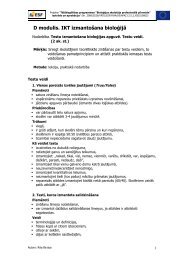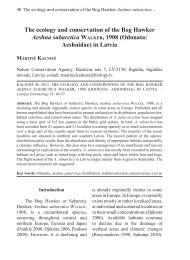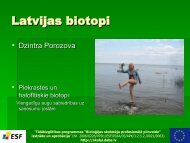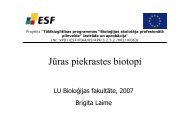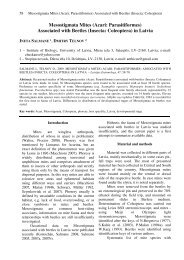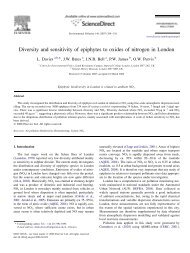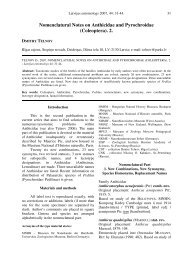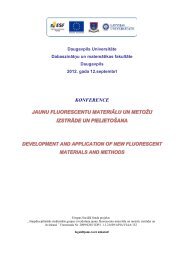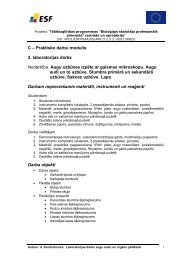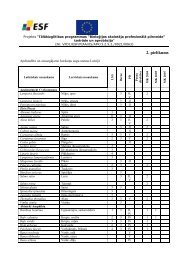Odonata - Entomological Society of Latvia - Latvijas Daba
Odonata - Entomological Society of Latvia - Latvijas Daba
Odonata - Entomological Society of Latvia - Latvijas Daba
You also want an ePaper? Increase the reach of your titles
YUMPU automatically turns print PDFs into web optimized ePapers that Google loves.
Figure 16. A distribution <strong>of</strong> Leucorrhinia pectoralis in <strong>Latvia</strong> in the 5x5 km square grid.<br />
The data on L. albifrons habitats were obtained from 130 water bodies, on L. caudalis from<br />
97 water bodies and on L. pectoralis from 160 water bodies. L. albifrons was mostly found in<br />
dystrophic lakes, L. caudalis in eutrophic lakes, but L. pectoralis in oxbow lakes (Table 10). From<br />
55 surveyed oxbows <strong>of</strong> the Gauja river L. albifrons was found in 2 oxbows, L. caudalis – in 14<br />
oxbows and L. pectoralis – in 36 oxbows.<br />
Table 10. The Leucorrhinia albifrons, L. caudalis and L. pectoralis selected habitats in <strong>Latvia</strong>.<br />
Species<br />
Mesotrophic<br />
lake<br />
Leucorrhinia albifrons 13<br />
(10 %)<br />
Leucorrhinia caudalis 6<br />
(6 %)<br />
Leucorrhinia pectoralis 7<br />
(4 %)<br />
Eutrophic<br />
lake<br />
41<br />
(32 %)<br />
49<br />
(51 %)<br />
41<br />
(26 %)<br />
Dystrophic<br />
lake<br />
62<br />
(48 %)<br />
16<br />
(16 %)<br />
40<br />
(25 %)<br />
Pond Oxbow Other<br />
4<br />
(3 %)<br />
5<br />
(5 %)<br />
9<br />
(6 %)<br />
2<br />
(2 %)<br />
17<br />
(18 %)<br />
51<br />
(32 %)<br />
8<br />
(6 %)<br />
4<br />
(4 %)<br />
12<br />
(8 %)<br />
During the study <strong>of</strong> 2005 in Tītmaņi oxbow, L. albifrons was found in two surveys in one<br />
sampling plot (three individuals), while L. caudalis was found in one survey in one sampling plot<br />
(one individual). L. pectoralis was found in six surveys in eight sampling plots (total 70<br />
individuals). The greatest number <strong>of</strong> individuals was found in sampling plots with open water pools<br />
and little shading (up to 30 %; No. 1, 2, 3, 4, 7). The dominating plants in these sampling plots were<br />
Menyanthes trifoliata, Stratiotes aloides, Glyceria fluitans, Carex nigra and Equisetum fluviatile,<br />
except for one sampling plot (No. 4), where Agrostis tenuis predominated. In two sampling plots<br />
(No. 5, 8), L. pectoralis was not found.<br />
66



